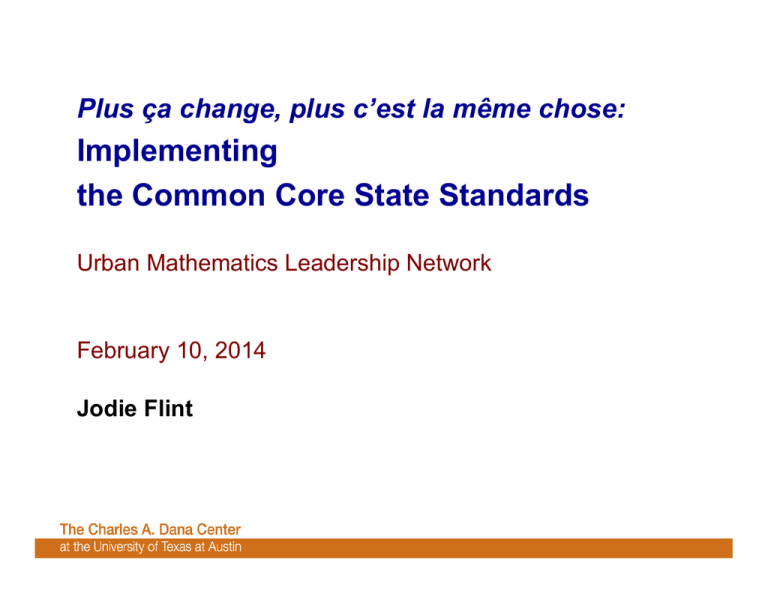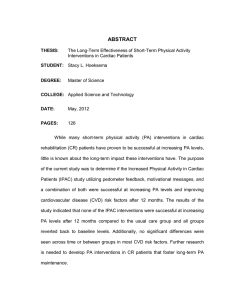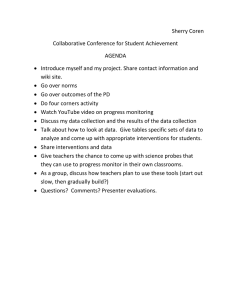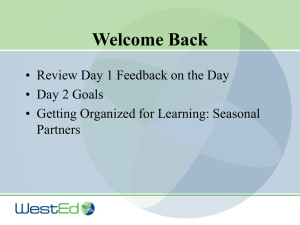Implementing the Common Core State Standards Urban Mathematics Leadership Network
advertisement

Plus ça change, plus c’est la même chose: Implementing the Common Core State Standards Urban Mathematics Leadership Network February 10, 2014 Jodie Flint Urban Mathematics Leadership Network Norms • • • • “I don’t know” is an acceptable answer. The 70/30 rule: If we get 70% correct, we’re celebrating! Smile, laugh, and smile some more. No one has all the answers, and everyone has part of the answers. • Listening is as important as speaking. • Document, document, document: The pyramids are really just aggregated bits of sand. 2 Learning Expectations Participants will… • Use elements of the Concerns-Based Adoption Model to support humans in the change process— particularly, implementing CCSSM to ensure that all students are college and career ready. • Use the Levels of Use scale to design supportive change interventions for people in our systems. 4 A framework for understanding and predicting change Concerns-Based Adoption Model • Change … • …is a PROCESS, not an event. • …is accomplished by INDIVIDUALS first, then institutions. • …is a highly PERSONAL experience. • …entails DEVELOPMENTAL growth in feelings and skills. • …is best understood in OPERATIONAL terms. 5 A framework for understanding and predicting change Concerns-Based Adoption Model “Human emotions and behaviors are much more complex, especially when it comes to their dynamics during times of change.” Hall, G. E. and Hord, S. M. (2006). Implementing change: Patterns, principles, and potholes, 2nd ed. Boston: Allyn and Bacon (an imprint of Pearson Educational), p. 174. 6 C-BAM Elements Probing Stages of Concern Resource System Change Facilitator Team i i i i i Users and Non-Users Levels of Use Innovation Configurations i i i i i i i Intervening 8 A framework for understanding and predicting change Concerns-Based Adoption Model Levels of Use (LoU) a scale that describes behaviors and portrays how people are acting with respect to specified change. 10 A framework for understanding and predicting change Levels of Use Levels of Use Behaviors The user is seeking more effective alternatives to the established use of the innovation. VI Renewal V Integration IVB Refinement IVA Routine III Mechanical The user is using the innovation in a poorly coordinated manner and is making user-oriented changes. II Preparation The user is preparing to use the innovation. I Orientation The user is seeking out information about the innovation. 0 Non-Use The user is making deliberate efforts to coordinate with others in using the innovation. The user is making changes to increase outcomes. The user is making few or no changes and has an established pattern of use. No action is being taken with respect to the innovation. 11 C-BAM Levels of Use “If no support and facilitating interventions are offered, many will never fully implement the innovation and others will remain nonusers. …[T]hose who are at Mechanical Use need interventions that will help them move beyond this level, or they may adapt the innovation to make it easier for them to manage or they may stop using the new practice altogether.” Hall, G. E. and Hord, S. M. (2006). Implementing change: Patterns, principles, and potholes, 2nd ed. Boston: Allyn and Bacon (an imprint of Pearson Educational). 13 C-BAM Levels of Use: Decision Points Orientation –User has acquired information about the innovation and is exploring/has explored what it means to students and the demands for use. Preparation –User is preparing for first use of the innovation; user has decided to use the innovation and has established a time to begin. During this non-use period, individuals need information about purposes and requirements of the change; about required materials and equipment; and practical advice on how to get started. 15 C-BAM Levels of Use: Decision Points Mechanical – User focuses most effort on the short-term, day-to-day use of the innovation with little time for reflection. Changes in use are made more to meet user needs than client needs. The user is primarily engaged in following the steps required to use the innovation, often resulting in disjointed and superficial use. During this period, the user typically needs help in finding and organizing materials; finding time to plan; finding time to problem-solve with an experienced user; experimenting with ways to handle various portions of the innovation; and addressing innovation-related surprises that surface. 16 C-BAM Levels of Use: Decision Points Routine – Use of innovation is stabilized. Few if any changes are being made in ongoing use. Little preparation or thought is being given to improving the innovation use or its consequences. Routine users who meet the expectations of the innovation need to be recognized for their efforts; routine users with a less-than-desirable pattern of use also need encouragement to further refine their practice. 17 C-BAM Levels of Use: Interventions to Support Use of the Innovation In what ways might we design a suite of interventions to support successful transitions within each innovation? Orientation à Preparation à Mechanical Use Mechanical Use à Routine 18 C-BAM Levels of Use: Interventions to Support Use of the Innovation What might those interventions look like? What data sources will inform the interventions? • How will we know who needs what when? • How might we stage the interventions appropriately? How will we know if the interventions are working? 19 Levels of Use: Planning Interventions Input Mechanical Transition Preparation Knowledge Knows surface requirements, resources, and timing for initial use; understands some initial experiences for students. Urban Mathematics Leadership Network The Charles A. Dana Center Output Practice Acquiring Information Sharing Assessing Planning Status Reporting Performing Seeks information and resources specifically related to preparation for use of the innovation in the classroom. Discusses resources needed; joins others in pre-use training and planning (resources, logistics, schedules) for first use. Analyzes requirements and available resources for initial use of innovation. Identifies steps and procedures to obtain resources, to engage in organizing activities, or to start using the innovation. Reports preparing self for initial use. Studies reference materials in depth, organizes resources and logistics, schedules and receives training. How can everyone access information quickly? Is information the same for everyone? How will we keep info sources (websites, FAQs, newsletters, training, etc.) current? How can we get the right stuff to the right people at the right time? Do colleagues have time to share and plan? How might we leverage that time? How might we support teachers to reflect about their implementation? Do planning tools align to the expectations of CCSS? How do teachers know what to do when they encounter a managerial or logistical surprise? How might we support the organization and distribution of resources? How might teachers share tips and resources? How do we ensure that everyone has time and space to study indepth? How do we train everyone? How might we gather and use classroom data? Knows on a day-to-day basis the requirements; has more knowledge of short-term activities and effects than longterm activities and effects. Discusses management issues; resources and materials are shared (to reduce issues with mgmt., flow, logistics). Manages innovation with varying degrees of efficiency. Often lacks anticipation of immediate consequences; the flow of actions is often disjointed, uneven, and uncertain. Changes are made primarily in response to logistical, organizational problems. Solicits management information about such things as logistics, scheduling, and ideas for reducing time and effort required. Examines own use of innovation looking for problems of logistics, mgmt., time schedules, resources, and general reactions of clients. Plans for organizing and managing resources, activities, and events related primarily to immediate on-going use of innovation. Plannedfor changes address managerial or logistical issues with a short-term perspective. Reports that logistics, time, management, resource organization, etc. are the focus of most personal efforts to use the innovation. Adapted from Hall, G. E., Loucks, S. F., Rutherford, W. I. & Newlove, B. W. (1975). Levels of Use of the Innovation: A framework for analyzing innovation adoption. The Journal of Teacher Education, 26(1), pp. 52-56. 1 Levels of Use: Planning Interventions Routine Transition Mechanical Input Urban Mathematics Leadership Network The Charles A. Dana Center Output Practice Knowledge Acquiring Information Sharing Assessing Planning Status Reporting Performing Knows on a day-to-day basis the requirements; has more knowledge of short-term activities and effects than longterm activities and effects. Solicits management information about such things as logistics, scheduling, and ideas for reducing time and effort required. Discusses management issues; resources and materials are shared (to reduce issues with mgmt., flow, logistics). Examines own use of innovation looking for problems of logistics, mgmt., time schedules, resources, and general reactions of clients. Plans for organizing and managing resources, activities, and events related primarily to immediate on-going use of innovation. Plannedfor changes address managerial or logistical issues with a short-term perspective. Reports that logistics, time, management, resource organization, etc. are the focus of most personal efforts to use the innovation. Manages innovation with varying degrees of efficiency. Often lacks anticipation of immediate consequences; the flow of actions is often disjointed, uneven, and uncertain. Changes are made primarily in response to logistical, organizational problems. How do we build on short-term success? How do we maintain a focus on long-term outcomes? How do we ensure a common understanding of long-term requirements and outcomes? How do we keep info sources (websites, FAQs, newsletters, training, etc.) current? How might we support the organization and distribution of resources? How might we support teachers to reflect about their implementation? How might teachers share tips and resources? In what ways might teachers check their practice against the expectations of the innovation? What sorts of opportunities might teachers need to ensure common use of the innovation? What data might instructional leaders need to gather to ensure fidelity to the innovation? When and where can teachers see effective use of the innovation? How can we ensure fidelity to the innovation? Knows both short-term and long-term requirements for use and how to use the innovation with minimum effort or stress. Describes current use of the innovation with little or no reference to ways of changing use. Uses the innovation smoothly with minimal management problems, over time, there is little variation in pattern of use. Makes no special efforts to seek information as a part of ongoing use of the innovation. Limits evaluation activities to those administratively required; little attention to findings for the purpose of changing use. Plans intermediate and long-range actions; little projected variation in how the innovation will be used. Planning routine use of resources, materials, etc. Reports that personal use of the innovation is going along satisfactorily with few if any problems. Adapted from Hall, G. E., Loucks, S. F., Rutherford, W. I. & Newlove, B. W. (1975). Levels of Use of the Innovation: A framework for analyzing innovation adoption. The Journal of Teacher Education, 26(1), pp. 52-56. 2







